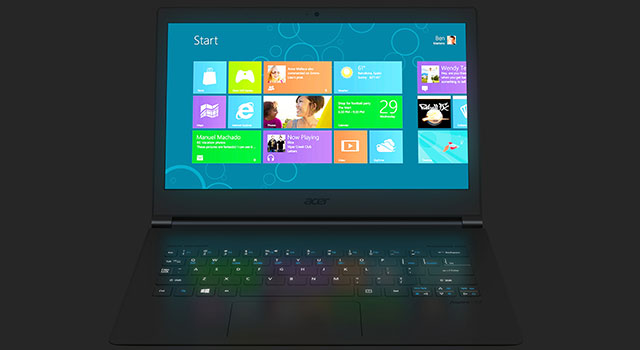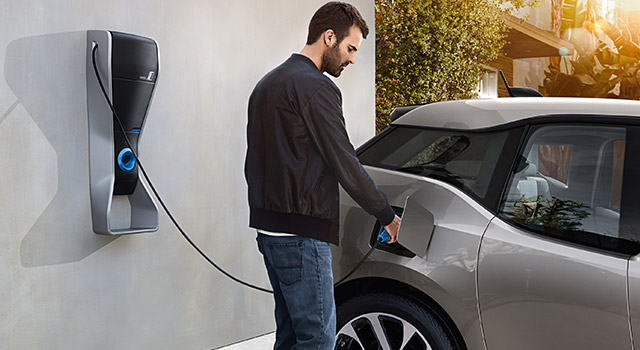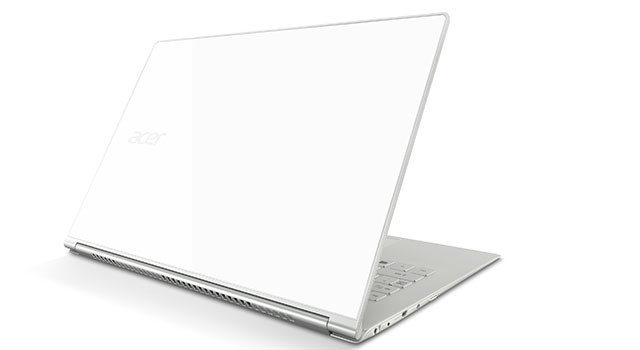
This beauty’s a head turner! When Acer’s new top-end Ultrabook, the Aspire S7, arrived in TechCentral’s offices last week, it was like a supermodel had entered the room.
There’s no doubt that Acer, whose previous Ultrabooks have underwhelmed next to the competition, is back in the game in a big way.
You see, the S7 is one of the best-looking Ultrabooks we’ve seen to date. It’s even sexier — and we don’t say this lightly — than Apple’s MacBook Air, the product it’s inevitably going to be compared to. It’s far from cheap, of course, and there are, unfortunately some drawbacks, including a weak battery, but more about that later in the review.
If first impressions count, then we expect it’s going to be love at first sight for many prospective owners of the Aspire S7. At just 11,9mm thick, and with a stunning white shell — the top is covered with a layer of Gorilla Glass 2 — that has to be seen to be believed, the S7 is simply drop-dead gorgeous. And it’s light, at less than 1,3kg for the 13,3-inch model we reviewed. There’s also an 11-inch version, though the focus of this review is the 13-incher.
After the sleek body of the S7 has suitably impressed, its screen is the next feature that stands out. The Windows 8-powered machine has a multi-touch display with full-high-definition resolution of 1 920×1 080 pixels. That’s almost, but not quite, in Apple’s “Retina” territory. The equivalently sized MacBook Pro with 13,3-inch screen has a resolution of 2 560×1 600. Of course, the Apple machine is not touch-enabled.

Fonts rendered on the S7 look crisp and images are incredibly sharp. And it’s surprising how often one touches the screen while using the machine, especially when on the Windows 8 Start screen and using applications designed for Microsoft’s new touch-orientated interface. You’ll just need to give it a spray and a wipe fairly often to stop fingerprints and grime from building up.
Our model — and the model that appears to be for sale in South Africa — is kitted out with an Intel Core i7-3517U processor and a generous 256GB solid-state drive. Acer has been a little stingy on the RAM, though: the unit comes with only 4GB. Still, its performance for basic tasks like e-mail and Web browsing is snappy. Understandably, you’ll want more RAM if you use resource-sapping applications on a regular basis.
The right-hand side of the laptop features two USB 3 ports. Although we’re glad Acer has dispensed of USB 2 with this machine, we’d have liked the supplied ports to have been spaced further apart. One large flash drive or modem and the other port becomes inaccessible.
Also on the right is a multifunction card-reader slot, and the left-hand side of the S7 includes the charging port, micro-HDMI port, 3,5mm audio jack and a discrete power button.
Lifting the screen reveals a well-designed and spacious backlit keyboard that we loved at first but soon found a few niggles with it as we began using it. As with other Acer Ultrabooks, the arrow keys are too small, meaning you often end up jabbing the Home/PgUp button instead of scroll-left or the PgDn/End button instead of scroll-right. And because there isn’t a great deal of free play on the somewhat recessed keys (no doubt to help achieve the S7’s slim profile), you’re not always 100% sure you’ve depressed them. The S7’s keyboard is a great improvement on older Acer keyboards, but it’s still not quite as good as those made by rivals Apple and Lenovo.
The S7’s two biggest disappointments are its touchpad, which is not as responsive as it should be, and its battery. We found ourselves using the touchscreen at times after we became frustrated with the touchpad. And in our usage, the battery didn’t last more than four hours from a full charge. That’s a potential deal breaker for road warriors who don’t want to lug a power cable or extra battery around with them everywhere they go.

Another problem is the price. The recommended retail price is R24 999, which is simply too expensive, especially given the machine has only 4GB of RAM. The same-specced machine in the US retails for less than US$1 700, so we’re not sure, even with the recent depreciation in the value of the rand, why it’s attracting quite such a premium in South Africa.
All in all, though, the Aspire S7 is a major step forward for Acer, whose previous Ultrabooks have proved uninspiring at best. The machine is also a good advertisement for where touch-based Windows 8 Ultrabooks are headed and it’s a future we’re really starting to like. — (c) 2013 NewsCentral Media

